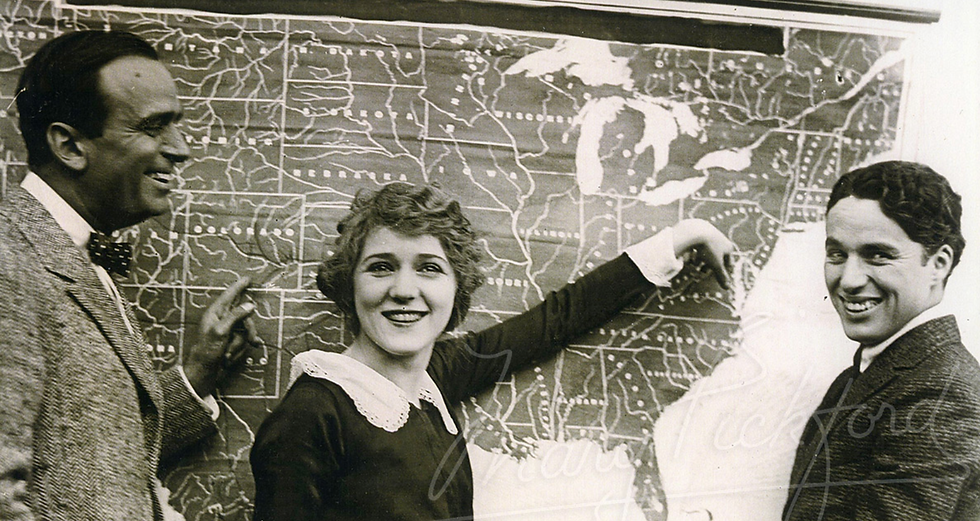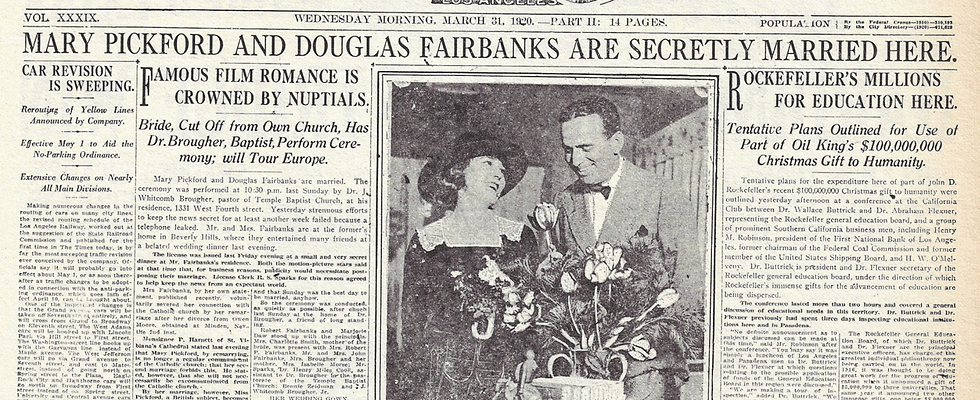Film Stardom
Following his recruitment by D. W. Griffith’s film studio The Fine Arts Film Company, in 1915, came the chance to build upon his vaudeville success with his shift into the film industry (Vance, p.25). Even before the release of his first film later that year, Douglas Fairbanks wielded immense power within his contract with The Fine Arts Film Company. This power manifested through the fact that he received a $500 semi-annual raise (Vance, p.25), but that his contract explicitly stated that all of his films had to be overseen by D. W. Griffith personally (Vance, p.25).
_edited.jpg)
His breakout role occurred not long after, with the release of the 1915 film The Lamb. In this film, Fairbanks played a lazy individual who is thrust into a Wild West adventure after a gang of criminals kidnaps him. Following his escape, his character has several run-ins with hostile Native American tribes before he escapes this predicament along with a damsel-in-distress. Upon the film’s completion, it debuted in New York City, where it was billed as a prestige film with prominent figures like William Randolf Hearst in attendance (Vance, p.28 ).
It was through this film and his 1916 film His Picture in the Papers, where Fiarbanks established himself as an actor who liked to take roles where he could display both his vigor and athleticism (Vance, p.29). This image helped him to become the symbol of these traits in the eyes of the American public. This, along with his 1917 film A Modern Musketeer, earned him the public moniker of “Everybody’s Hero.” This public persona came in handy when he went on war bonds tours when the United States entered WWI in 1917.

The next big evolution in his public persona came in 1917 when he left The Fine Arts Film Company and started his own production company called Douglas Fairbanks Picture Corporation (Vance, p.38). The reason behind this shift was to not only produce the films that he starred in but to continue showing off his now famous physic in his films (Vance, p.39). By vertically integrating parts of his film’s aspects of production, Fairbanks could exert more control over every aspect of the films that he starred in.

During World War I, Fairbanks toured throughout the nation’s major East-Coast cities with Marie Dressler, Charlie Chaplin, and Mary Pickford before doing a solo Liberty Bonds tour across the Midwest (Vance, p.47). Also, Fairbanks starred in two propaganda films which were free for Americans to watch (Vance, p.47). This was done in order to increase the nation’s wartime morale. However, the biggest impact that this opportunity had on Fairbanks’ career were the relationships that he forged with Charlie Chaplin and Mary Pictford.

These relationships led to Douglas Fairbanks, Charlie Chaplin, Mary Pickford, and D. W. Griffith creating their own production company called The United Artists Corporation in early 1919 (Vance, p.71). The purpose of The United Artists Corporation was to allow both its creators and other producers, to keep more of the profits from their films’ production instead of paying so much to film distributors (Vance, p.72). As a result, this allowed each artist to create more of the films that they wanted to produce, instead of having a specific studio tell them what films they were to star in. As a result, this act of rebellion went against the conventional studio system by allowing them to produce films that were independent of the formulaic productions that were common in the studio system.

However, one major impact that The United Artists Corporation had on Fairbanks was that it caused him to fall in love with Mary Pictford. He divorced his wife in 1919, so he could marry Mary Pictford (Vance, p.62). This relationship captured the public's imagination as they would regularly go on European vacations together (Vance, p.63). Furthermore, they both used their star power to capture the public’s imagination with a lavish Hollywood home. This home was referred to as “Pickfair” by the press, and served as a way for them to project their combined celebrity soft power. However, this power couple did not last as they divorced in early 1936. In their divorce settlement, Mary became the sole owner of their “Pickfair” estate, while Fairbanks became the sole owner of their Santa Monica beach house, and their ranch known as “Ranch Zorro” (Vance, p.301).
Another major impact was that The United Artists Corporation allowed Douglas Fairbanks to star in films that would turn him into an icon. The most well-known of these films are: The Mask of Zorro (1920), The Three Musketeers (1921), Robin Hood (1922), The Thief of Bagdad (1924), The Black Pirate (1926), and The Iron Mask (1929). What all of these films had in common was that they allowed Fairbanks to continue to play roles which gave him the chance to demonstrate his now widely known personal athleticism. Furthermore, these films made him famous for not only his swordsmanship but his ability to perform all of his own stunts (Vance, p.135). Consequently, this caused his celebrity status to expand even more.
